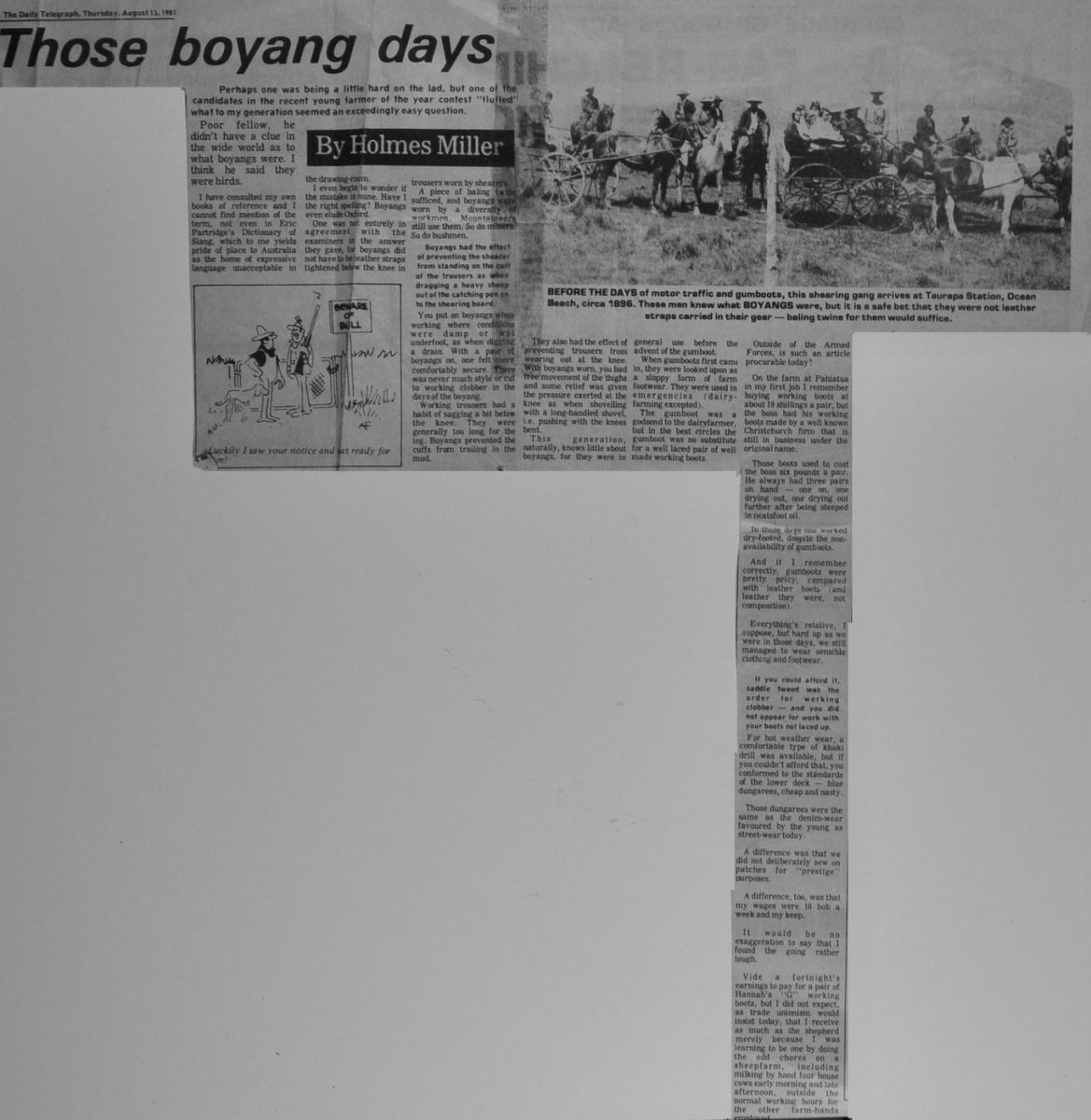The Daily Telegraph, Thursday, August 13, 1981
Those boyang days
By Holmes Miller
Perhaps one was being a little hard on the lad, but one of the candidates in the recent young farmer of the year contest “fluffed” what to my generation seemed an exceedingly easy question.
Poor fellow, he didn’t have a clue in the wide world as to what boyangs were. I think he said they were birds.
I have consulted my own books of reference and I cannot find mention of the term, not even in Eric Partridge’s Dictionary of Slang, which to me yields pride of place to Australia as the home of expressive language unacceptable in the drawing-room.
I even begin to wonder if the mistake is mine. Have I the right spelling? Boyangs even elude Oxford.
One was not entirely in agreement with the examiners in the answer they gave, for boyangs did not have to be leather straps tightened below the knee in trousers worn by shearers.
A piece of baling twine sufficed, and boyangs were worn by a diversity of workmen. Mountaineers still use them. So do miners. So do bushmen.
Boyangs had the effect of preventing the shearer from standing on the cuff of the trousers as when dragging a heavy sheep out of the catching pen on to the shearing board.
You put on boyangs when working where conditions were damp or wet underfoot, as when digging a drain. With a pair of boyangs on, one felt more comfortably secure. There was never much style or cut to working clobber in the days of the boyang.
Working trousers had a habit of sagging a bit below the knee. They were generally too long for the leg. Boyangs prevented the cuffs from trailing in the mud.
They also had the effect of preventing trousers from wearing out at the knee. With boyangs worn, you had free movement of the thighs and some relief was given the pressure exerted at the knee as when shovelling with a long-handled shovel, i.e. pushing with the knees bent.
This generation, naturally, knows little about boyangs, for they were in general use before the advent of the gumboot.
When gumboots first came in, they were looked upon as a sloppy form of farm footwear. They were used in emergencies (dairyfarming excepted).
The gumboot was a godsend to the dairyfarmer, but in the best circles the gumboot was no substitute for a well laced pair of well made working boots.
Outside of the Armed Forces, is such an article procurable today?
On the farm at Pahiatua in my first job I remember buying working boots at about 19 shillings a pair, but the boss had his working boots made by a well known Christchurch firm that is still in business under the original name.
Those boots used to cost the boss six pounds a pair. He always had three pairs on hand – one on, one drying out, one drying out further after being steeped in neatsfoot oil.
In those days one worked dry-footed, despite the non-availability of gumboots.
And if I remember correctly, gumboots were pretty pricy, compared with leather boots (and leather they were, not composition).
Everything’s relative, I suppose, but hard up as we were in those days, we still managed to wear sensible clothing and footwear.
If you could afford it, saddle tweed was the order for working clobber – and you did not appear for work with your boots not laced up.
For hot weather wear, a comfortable type of khaki drill was available, but if you couldn’t afford that, you conformed to the standards of the lower deck – blue dungarees, cheap and nasty.
Those dungarees were the same as the denim-wear favoured by the young as street-wear today.
A difference was that we did not deliberately sew on patches for “prestige” purposes.
A difference, too, was that my wages were 10 bob a week and my keep.
It would be no exaggeration to say that I found the going rather tough.
Vide a fortnight’s earnings to pay for a pair of Hannah’s “G” working boots, but I did not expect, as trade unionism would insist today, that I receive as much as the shepherd merely because I was learning to be one by doing the odd chores on a sheepfarm, including milking by hand four house cows early morning and late afternoon, outside the normal working hours for the other farm-hands employed.
Photo caption – BEFORE THE DAYS of motor traffic and gumboots, this shearing gang arrives at Taurapa Station, Ocean Beach, circa 1896. These men knew what BOYANGS were, but it is a safe bet that they were not leather straps carried in their gear – baling twine for them would suffice.
Cartoon caption – BEWARE OF BULL – Luckily I saw your notice and was ready for him!












Do you know something about this record?
Please note we cannot verify the accuracy of any information posted by the community.